|
|
|
Sort Order |
|
|
|
Items / Page
|
|
|
|
|
|
|
| Srl | Item |
| 1 |
ID:
171172
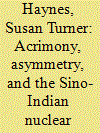

|
|
|
|
|
| Summary/Abstract |
While most contemporary analyses of South Asian nuclear dynamics acknowledge the presence of a strategic triangle between the region’s three nuclear players, the primary focus usually remains on the rivalry between India and Pakistan. Discussions of Sino-Indian relations remain limited. This is likely attributed to the stability in the two countries’ relations, yet it is worth asking why this stability exists and whether it is likely to continue in the future. Although China and India have an acrimonious relationship, their asymmetric nuclear capabilities and threat perceptions mitigate the danger of a traditional security dilemma. India may perceive China’s nuclear aggrandizement to be a security threat, but the same is not true of China, which has a vastly superior nuclear force and is largely shaping its nuclear-force structure in response to the threat it perceives from the United States. This dynamic makes a serious conventional or nuclear conflict highly unlikely.
|
|
|
|
|
|
|
|
|
|
|
|
|
|
|
|
| 2 |
ID:
125567


|
|
|
|
|
| Publication |
2013.
|
| Summary/Abstract |
The overthrow of Libyan leader Muammar Ghadaffi in 2011 prompted a flood of weapons into north Africa and the Middle East. Cameron Scott investigates the rise of illicit arms trafficking and its effects on regional stability.
|
|
|
|
|
|
|
|
|
|
|
|
|
|
|
|
| 3 |
ID:
126586


|
|
|
|
|
| Publication |
2013.
|
| Summary/Abstract |
Using the 'achievement index', a country's relative size of gross domestic product divided by its relative size of population, I argue that the high-achieving position of the West, as a structural distortion, has been a principal source of instability in the modern international system. Rather than being just unsatisfied great powers, large high achievers and stagnant low achievers engage in hegemonic and counter-hegemonic warfare, respectively. Both hierarchy and balancing systems are structurally more stable if they are 'natural' and less stable if they are 'unnatural', with being natural defined as an achievement index of 1. The rise of the rest constitutes a long-term trend back to nature, beginning to flatten the heretofore skewed international structure, which lessens one source of modern system-level instability. With a much larger share of world population, China cannot rise to the same relative height as the West that rose with a much smaller share of the population. China's rise is thus unlikely to repeat the past experience of the rising West.
|
|
|
|
|
|
|
|
|
|
|
|
|
|
|
|
| 4 |
ID:
131026
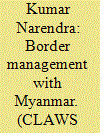

|
|
|
|
|
| Publication |
2014.
|
| Summary/Abstract |
Neighbouring states are most relevant in foreign policy' and Myanmar, indeed, has strategic, economic, cultural and religious signi?cance for India. Myanmar is not where only China and India 'meet'; it is also the intersection between South Asia and Southeast Asiaz. It is a gateway to South Asia and a land bridge to the Association for Southeast Asian Nations (ASEAN). It is an opportunity and also brings with it a certain amount of vulnerabilities as well. Myanmar has huge potential for meeting India's energy requirement and for markets for Indian consumer goods; in return, India can contribute immensely in the field of infrastructure development, communication, education, tourism industry, science and technology. India and Myanmar are historically linked to each other through religion, people-to-people contact and sharing ethnically identical populations on both sides of the borders. The porous land borders of India and Myanmar are a cause of concern for peace, stability and economic development. Inhospitable terrain and an underdeveloped border region provide an ideal platform for insurgents, non-state actors, drugs and weapons traffickers to operate and spread their network
|
|
|
|
|
|
|
|
|
|
|
|
|
|
|
|
| 5 |
ID:
146996
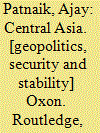

|
|
|
|
|
| Publication |
Oxon, Routledge, 2016.
|
| Description |
xviii, 237p.hbk
|
| Standard Number |
9781138215757
|
|
|
|
|
|
|
|
|
|
|
|
Copies: C:1/I:0,R:0,Q:0
Circulation
| Accession# | Call# | Current Location | Status | Policy | Location |
| 058771 | 327.58/PAT 058771 | Main | On Shelf | General | |
|
|
|
|
| 6 |
ID:
133855
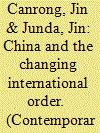

|
|
|
|
|
| Publication |
2014.
|
| Summary/Abstract |
From the beginning of 2014, the international order has undergone some quite dramatic changes in several parts of the world. The Ukrainian political crisis has gradually evolved into a U.S-Russia confrontation two decades after the end of cold war. In the Middle East, the extremist group, the Islamic State of Iraq and Al Sham (ISIS) invaded Iraq gaining much territory in the north of the country. Iraq has become a new unstable element in the Middle East. In Africa, the aftershock of the Arab Spring can be seen most prominently in Egypt and Libya. South Sudan and Central Africa are plagued by civil war. In the Asia-Pacific region Sino-Vietnam and Sino-Japanese Conflict have escalated and Japan has lifted a ban on collective self defence which threaten China's neighborhood security and regional stability.
|
|
|
|
|
|
|
|
|
|
|
|
|
|
|
|
| 7 |
ID:
140977
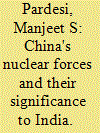

|
|
|
|
|
| Summary/Abstract |
The Indian nuclear program is a response to a perceived politico-strategic threat from China as opposed to a military-operational one that New Delhi began after perceiving an “ultimatum” from China in 1965. Consequently, India is in the process of acquiring an assured second-strike capability vis-à-vis China to meet the requirements of general deterrence. While India has always been concerned about the Sino-Pakistani nuclear/missile nexus, China has become wary of the growing military ties between the United States and India in recent years, especially because of the military implications of the US-India civil nuclear deal. Given the growing conventional military gap between the two states, India is not lowering its nuclear threshold to meet the Chinese conventional challenge. Instead, India is upgrading its conventional military strategy from dissuasion to deterrence against China. While the overall Sino-Indian nuclear relationship is stable, it will be challenged as China acquires advanced conventional weapons that blur the distinction between conventional and nuclear conflict.
|
|
|
|
|
|
|
|
|
|
|
|
|
|
|
|
| 8 |
ID:
126585
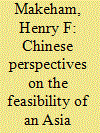

|
|
|
|
|
| Publication |
2013.
|
| Summary/Abstract |
The ongoing worries complicating China's rise are exacerbated by China's perceived double-bind dilemma: China is attacked as a threat to regional stability when it is active in the regional arena and damned as an irresponsible stakeholder when it is not. As an emerging global power China is naturally seeking to secure its ever-increasing interests abroad. Therefore, China's double-bind will intensify as China's foreign policy evolves from 'biding its time and hiding its capacities' to that of an increasingly proactive regional actor. The author argues that, in light of this likely transition in Chinese foreign policy conduct, the time is more pressing than ever before to mitigate anxieties and maximise the chances of China's positive-sum integration within the region. The argument correlates with the proposal by Australian Prime Minister Kevin Rudd in 2008 that the region begin contemplating the realisation of an Asia Pacific community (APc) concept, as a framework to rehabilitate the region's multilateral architectural mélange and implicitly reform the ASEAN Way-driven modus operandi with a more muscular APc Way. Such an outcome may be realised through streamlining the region's institutional alphabet soup and reforming the lacklustre ASEAN Way.
|
|
|
|
|
|
|
|
|
|
|
|
|
|
|
|
| 9 |
ID:
171176
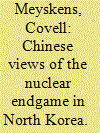

|
|
|
|
|
| Summary/Abstract |
This article examines Chinese views of North Korea’s nuclear-weapon program during the Donald J. Trump administration. It shows that China has portrayed itself as a responsible country that promotes regional stability, unlike the United States, which has engaged in military brinkmanship with North Korea. Some Chinese foreign-policy experts have asserted that Beijing should back Pyongyang in the event of war because of their shared history of humiliation by great powers, while others have favored working with other regional partners. Another theme in Chinese discourse about North Korea is that Pyongyang is an impetuous, ungrateful regime that impedes Beijing’s ability to attain its core interests of regional stability, economic development, and heightened global influence. This negative assessment of North Korea drove Beijing’s endorsement of stricter UN sanctions in 2017. While Beijing has punished Pyongyang for its wayward policies, China responded favorably to North Korea’s decision in April 2018 to stop nuclear tests and partake in international dialogue. Beijing seeks to help Pyongyang gradually disarm and develop its economy within a Chinese-led East Asian order. The article concludes by explaining how Beijing’s recent, more positive view of Pyongyang is likely to affect its support for American efforts to dismantle North Korea’s nuclear-weapon program.
|
|
|
|
|
|
|
|
|
|
|
|
|
|
|
|
| 10 |
ID:
134211
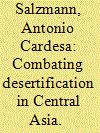

|
|
|
|
|
| Publication |
2014.
|
| Summary/Abstract |
This article appraises the Central Asian Countries' Initiative on Land Management (CACILM) as an innovative experience of regional co-operation to implement the Convention on Desertification. Despite high initial expectations, the actual implementation process has suffered drawbacks. The Central Asian countries' commitment and capacity to sustain this process depends heavily on international support. Moreover, the process's low political profile and the weak capacities of the Central Asian authorities to engage in meaningful transnational co-operation are significant hurdles to be tackled. At the same time, national and regional efforts to combat soil degradation and desertification have not yet been properly mainstreamed with other more consolidated processes for the sustainable management of natural resources, such as the IFAS. It is argued that this may be a possible solution for the future of CACILM.
|
|
|
|
|
|
|
|
|
|
|
|
|
|
|
|
| 11 |
ID:
133698
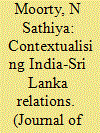

|
|
|
|
|
| Publication |
2014.
|
| Summary/Abstract |
Unlike what may have been reduced to in some circles, India- Sri Lanka relations are not a 'one-issue affair', centred on the vexatious ethnic problem in the island-nation, or on its influence and impact on
the south Indian State of Tamil Nadu. Instead, they continue to be multi-dimensional and multifarious, standing as testimony and test- case to the path of greater regional stability and cooperation, which
is in the interest of South Asia as a whole.
|
|
|
|
|
|
|
|
|
|
|
|
|
|
|
|
| 12 |
ID:
065261


|
|
|
| 13 |
ID:
111924
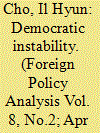

|
|
|
|
|
| Publication |
2012.
|
| Summary/Abstract |
During his tenure, President George W. Bush touted the East Asian democratic experience as a positive model for democratization in the Middle East. Contrary to the premise of democracy leading to regional stability, however, East Asian democracies in the past decade have often become a source of regional instability. Based on a comparative analysis of political developments in Taiwan, Japan, and South Korea, this paper explores the foreign policy behavior of East Asian democracies and assesses the overall impact on regional security dynamics. Specifically, I argue that incomplete democratic consolidation, combined with the political salience of national identity, sparked a process of acute intergroup competition among domestic political actors. As a result, the foreign policy orientation of the three East Asian democracies became belligerent, thereby unnecessarily increasing regional tensions.
|
|
|
|
|
|
|
|
|
|
|
|
|
|
|
|
| 14 |
ID:
179174
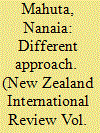

|
|
|
|
|
| Summary/Abstract |
The principles of partnership and mutual respect embodied in the Treaty of Waitangi provide the essential foundation for how New Zealand conducts its foreign policy today. Its approach is values-based and aims to work collectively in pursuit of our core interests. These include: defending an international rules-based order which gives all countries a voice and provides frameworks that promote stability; keeping New Zealanders safe by promoting regional stability; promoting and nurturing international conditions and connections that aid our prosperity, including supply chain resilience; and encouraging global action on sustainability issues such as climate change where solutions depend on international co-operation.
|
|
|
|
|
|
|
|
|
|
|
|
|
|
|
|
| 15 |
ID:
132381
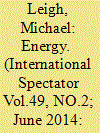

|
|
|
|
|
| Publication |
2014.
|
| Summary/Abstract |
Energy trade cannot overcome longstanding political conflicts. There are no 'peace pipelines' anywhere in the world. Rather peace is a condition for investment in pipelines and other forms of energy infrastructure. Where political breakthroughs have been achieved, however, energy trade can reinforce cooperation between states and contribute to regional stability. These considerations are particularly pertinent to the Cyprus settlement talks and Middle East Peace Process, against the background of energy discoveries in the Eastern Mediterranean.
|
|
|
|
|
|
|
|
|
|
|
|
|
|
|
|
| 16 |
ID:
137555
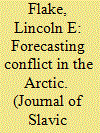

|
|
|
|
|
| Summary/Abstract |
The Arctic has reemerged as a region of geo-political consequence following rapid reduction in sea ice in the past decade. As the only non-NATO Arctic littoral state, Russia’s approaches to the many disputes in the region will undoubtedly have the greatest bearing on the future security environment. This article examines the two most threatening circumpolar disputes, sea bed delineation and navigation rights, and postulates that Russia’s policies on both issues conform to historical patterns. Recent Russian policy decisions are placed in historical context in order to gauge conflict potential in the Arctic related to these two disputes. The main finding is that the path-dependent trajectories of both issues are becoming ever more distinct as Russia articulates its Arctic policies. In particular, structural and historical factors encourage Moscow toward cooperation and compromise on sea bed negotiations but also suggest that Kremlin intransigence on navigation will continue, with potentially detrimental effect on regional stability.
|
|
|
|
|
|
|
|
|
|
|
|
|
|
|
|
| 17 |
ID:
097751
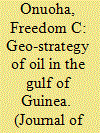

|
|
|
|
|
| Publication |
2010.
|
| Summary/Abstract |
This study highlights the security implications of the rising geo-strategic prominence of West Africa's Gulf of Guinea (GG) oil, deriving from the security calculus of the major oil-consuming countries. It argues that the extension of the traditional militaristic approach to energy security by major oil-consuming countries, particularly the US, to energy affairs in the GG will reignite the global arms race involving other major oil consumers including China. The logic being that energy-hungry China and others are also likely to respond with their own militaristic strategies to safeguard their own supplies in the GG. All of that will flood the sub-region with arms and weapons and further destabilize weak or fragile states in the sub-region. To avoid that situation and forestall the attendant consequences to states and inhabitants of the sub-region, the paper recommends that efforts must be made to entrench consistent dialogue, good governance and investment in human capital development.
|
|
|
|
|
|
|
|
|
|
|
|
|
|
|
|
| 18 |
ID:
168850


|
|
|
|
|
| Summary/Abstract |
U.S. security assistance programs are expected to increase the capabilities of partners in the Middle East and Africa by leveraging the provision of armaments and training through foreign aid. Can policymakers increase their reliance on such programs to achieve foreign policy aims of promoting regional stability while retaining political flexibility? Using multivariate logistic regression of Middle East and African states spanning 1970 to 2015, the empirical findings suggest that U.S. programs geared toward education and training are more positively correlated with stability than programs oriented toward providing hardware.
|
|
|
|
|
|
|
|
|
|
|
|
|
|
|
|
| 19 |
ID:
132925
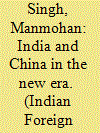

|
|
|
|
|
| Publication |
2014.
|
| Summary/Abstract |
Above all, India and China need a stable, secure and prosperous Asia Pacific region. The centre of gravity of global opportunities and challenges are shifting to this region. In the coming decades, China and India, together with the United States, Japan, Korea and the ASEAN Community, will be among the largest economies in the world. While this region embodies unparalleled dynamism and hope, it is also one with unsettled questions and unresolved disputes. It will be in our mutual interest to work for a cooperative, inclusive and rule-based security architecture that enhances our collective security and regional and global stability.
|
|
|
|
|
|
|
|
|
|
|
|
|
|
|
|
| 20 |
ID:
140979
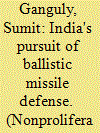

|
|
|
|
|
| Summary/Abstract |
This article analyzes India's efforts to deploy a Ballistic Missile Program (BMD). The article has three objectives. First, it argues that scientific-bureaucratic factors and India's incapacity to deter Pakistan's use of terrorist proxies have driven its quest for BMD. Second, the article also evaluates the current state of India's two-tiered missile defense shield. In spite of various claims on the part of India's defense science establishment, the paper estimates that India still lacks a deployable BMD system and is still far from developing an effective strategy of deterrence-through-denial. Third, the article analyzes the implications of the development of India's BMD system for nuclear stability in South Asia. The article shows how India's BMD capacities, however limited, have indirectly exacerbated the security concerns of India's regional rival, Pakistan.
|
|
|
|
|
|
|
|
|
|
|
|
|
|
|
|
|
|
|
|
|